
- •Contents
- •Course Overview
- •Course Agenda
- •Document Conventions
- •Additional Information
- •Chapter 1: Course Introduction
- •Chapter 2: Junos Operating System Fundamentals
- •The Junos OS
- •Traffic Processing
- •Overview of Junos Devices
- •Chapter 3: User Interface Options
- •User Interface Options
- •The Junos CLI: CLI Basics
- •The Junos CLI: Operational Mode
- •The Junos CLI: Configuration Mode
- •Lab 1: The Junos CLI
- •Chapter 4: Initial Configuration
- •Factory-Default Configuration
- •Initial Configuration
- •Interface Configuration
- •Lab 2: Initial System Configuration
- •Chapter 5: Secondary System Configuration
- •User Configuration and Authentication
- •System Logging and Tracing
- •Network Time Protocol
- •Archiving Configurations
- •SNMP
- •Lab 3: Secondary System Configuration
- •Monitoring Platform and Interface Operation
- •Network Utilities
- •Maintaining the Junos OS
- •Password Recovery
- •Lab 4: Operational Monitoring and Maintenance
- •Appendix A: Interface Configuration Examples
- •Review of the Interface Configuration Hierarchy
- •Interface Configuration Examples
- •Using Configuration Groups
- •Appendix B: The J-Web Interface
- •Configuration
- •Lab 5 (Optional): The J-Web Interface
- •Appendix C: Acronym List
- •Appendix D: Answer Key
- •Chapter 1: Course Introduction
- •Chapter 2: Junos Operating System Fundamentals
- •Chapter 3: User Interface Options
- •Chapter 4: Initial Configuration
- •Chapter 5: Secondary System Configuration
- •Chapter 6: Operational Monitoring and Maintenance

Introduction to the Junos Operating System
Chapter 5: Secondary System Configuration
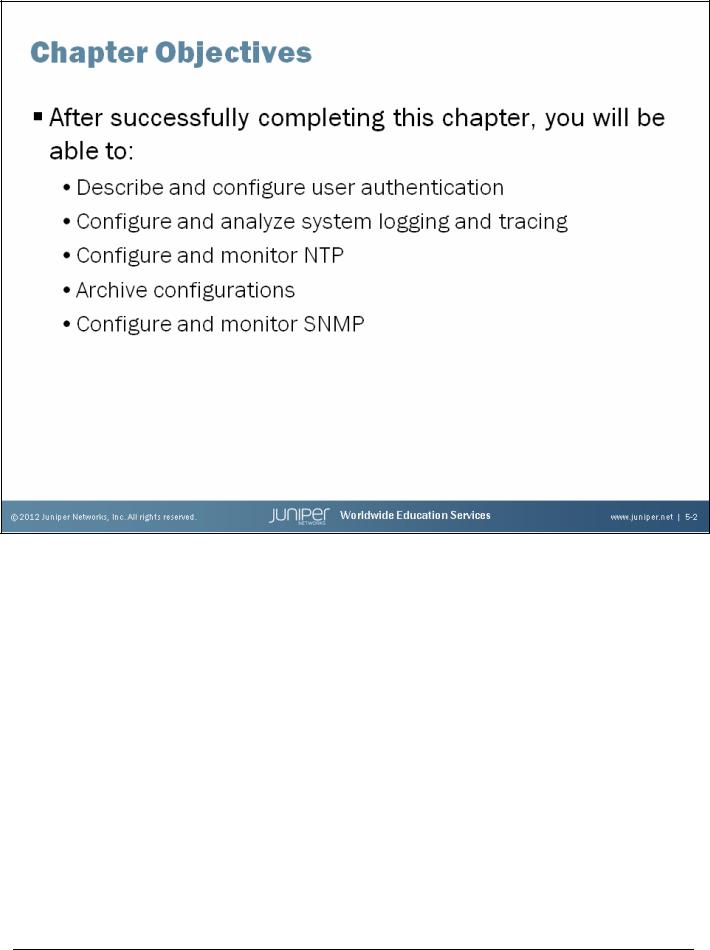
Introduction to the Junos Operating System
This Chapter Discusses:
•User authentication methods and configuration;
•Configuration and analysis of system logging and tracing;
•Network Time Protocol (NTP) configuration and operation;
•Archiving of configurations on remote devices; and
•Configuration and monitoring of SNMP.
Chapter 5–2 • Secondary System Configuration |
www.juniper.net |
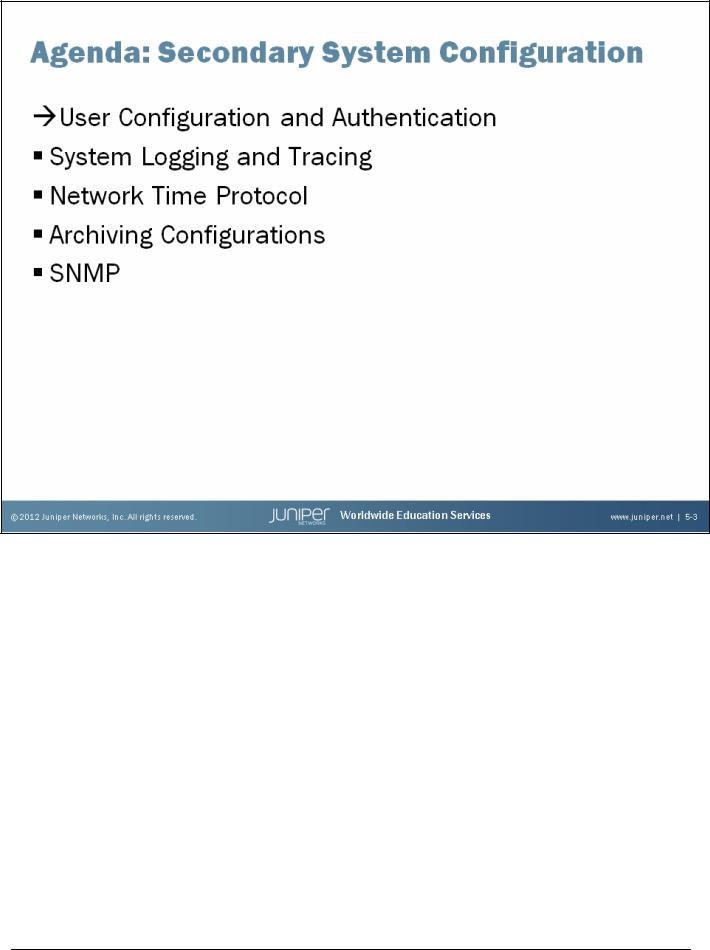
Introduction to the Junos Operating System
User Configuration and Authentication
The slide lists the topics we cover in this chapter. We discuss the highlighted topic first.
www.juniper.net |
Secondary System Configuration • Chapter 5–3 |
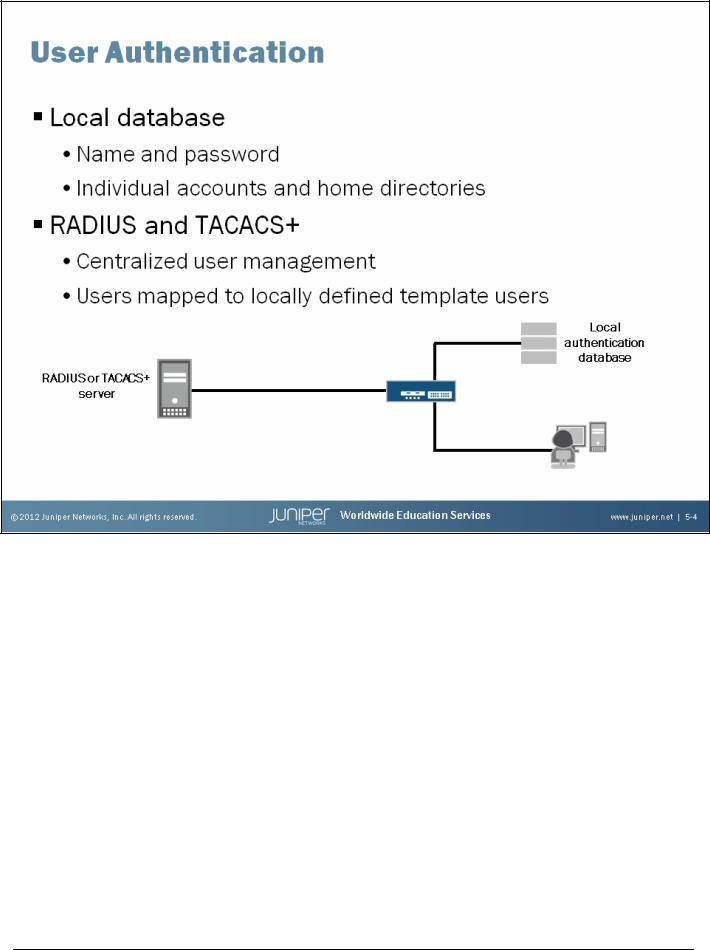
Introduction to the Junos Operating System
Local Password Authentication
With local password authentication, you can configure usernames and passwords individually for each user to log in to a device running the Junos operating system. The Junos OS enforces the following password restrictions:
•The password must be at least 6 characters;
•You can include most character classes in a password (alphabetic, numeric, and special characters), except control characters; and
•Passwords must contain at least one change of case or character class.
When a user is configured on a device running the Junos OS, the system automatically generates a home directory for that user. The home directory serves as the default working directory for each locally configured user. The user’s working directory can be changed for individual sessions using the operational mode set cli directory directory command.
Continued on the next page.
Chapter 5–4 • Secondary System Configuration |
www.juniper.net |

The remote user template account is used for all users that authenticate through RADIUS or TACACS+ that do not have a local user account configured.
Introduction to the Junos Operating System
RADIUS and TACACS+
RADIUS and TACACS+ are distributed client and server systems used as authentication methods to validate users. The RADIUS and TACACS+ clients run on devices running the Junos OS; the server runs on a host connected to a remote network. A locally defined user account determines authorization. Multiple RADIUS or TACACS+ authenticated users can be mapped to a locally defined template user account. Local template user accounts avoid the need for each RADIUS or TACACS+ user to also have a locally defined user account. With the appropriate Juniper Networks extensions loaded on the server, both RADIUS and TACACS+ can override these template user authorization parameters by passing extended regular expressions. Coverage of regular expressions is outside of the scope of this class.
www.juniper.net |
Secondary System Configuration • Chapter 5–5 |
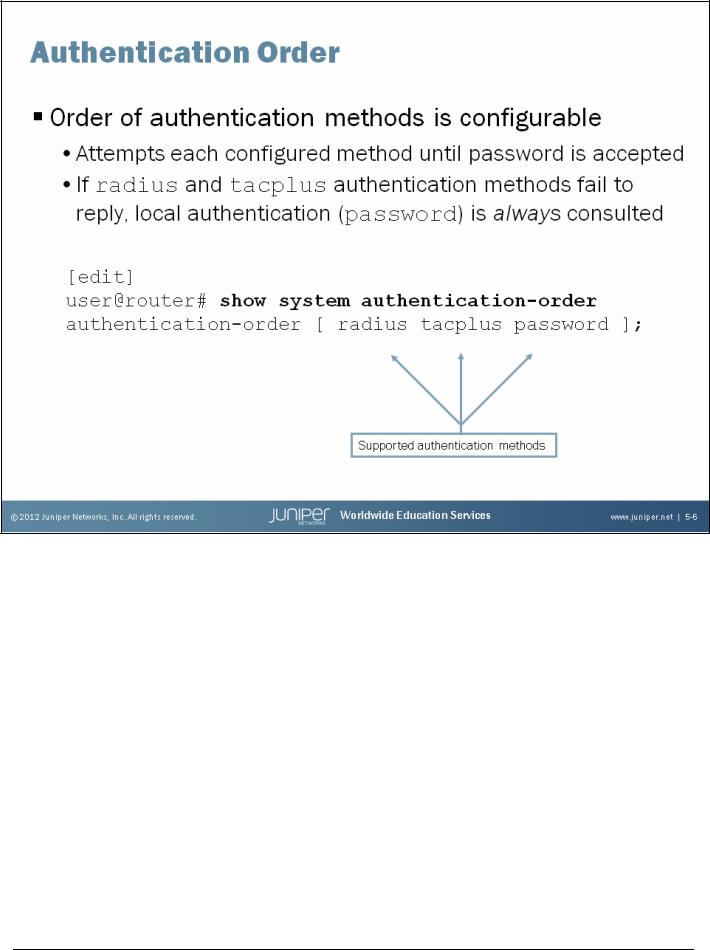
Introduction to the Junos Operating System
Authentication Order
You can configure devices running the Junos OS to be both a RADIUS and TACACS+ client, and you can prioritize the order in which the software tries one or more of the three different authentication methods.
For each login attempt, the Junos OS tries the authentication methods in order, until the password is accepted. The next method in the authentication order is consulted if the previous authentication method failed to reply or if the method rejected the login attempt. If no reply (accept or reject) is received from any of the listed authentication methods, the Junos OS consults local authentication as a last resort.
Chapter 5–6 • Secondary System Configuration |
www.juniper.net |
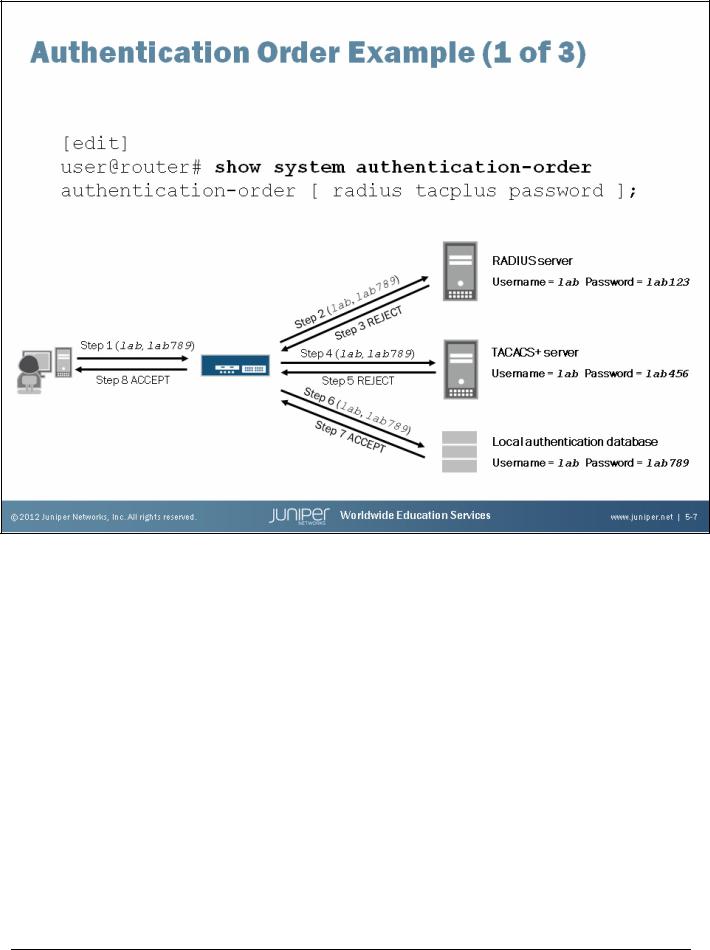
Introduction to the Junos Operating System
Example 1
In the example shown on the slide, we configured authentication-order [ radius tacplus password ]. We entered a username of lab and a password of lab789. We successfully authenticated because each configured authentication method is attempted until the password is accepted by the local authentication database.
In addition to the authentication order shown on the slide, you would also need to configure the RADIUS and TACACS+ servers as well as the lab user. The following is a sample of these configuration parameters:
[edit system]
user@router# show radius-server
172.18.102.13 secret "$9$9ZKntpBvMX7Nb1RcleW-dbs2gaU"; ## SECRET-DATA
[edit system]
user@router# show tacplus-server
172.17.32.14 secret "$9$m5T31Icyrvn/A0ORlevWLXNb"; ## SECRET-DATA
[edit system]
user@router# show login user lab class super-user;
authentication {
encrypted-password "$1$dJ3NA9BW$nZGLZAp9kpiG52kru34IT."; ## SECRET-DATA
}
www.juniper.net Secondary System Configuration • Chapter 5–7
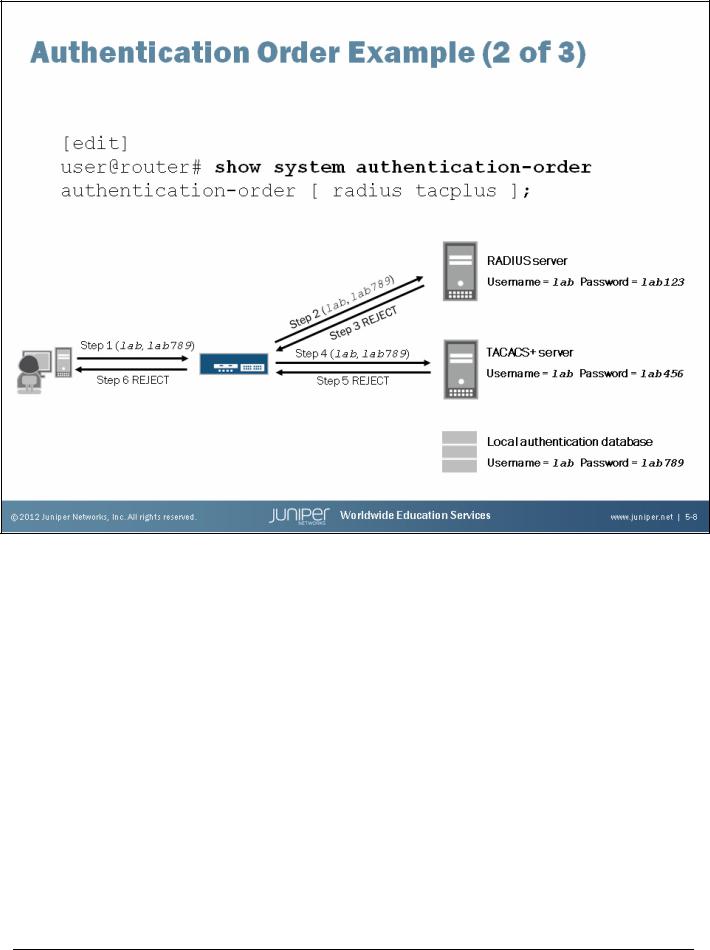
Introduction to the Junos Operating System
Example 2
In this example, we configured authentication-order [ radius tacplus ]. We entered a username of lab and a password of lab789. The Junos OS attempted to authenticate the password against the RADIUS server, which rejected it. It then attempted to authenticate the password against the TACACS+ server, which also rejected it. The Junos OS does not consult local authentication because it is not listed in the authentication order, and because at least one of the configured authentication methods did respond. The password was rejected.
Chapter 5–8 • Secondary System Configuration |
www.juniper.net |
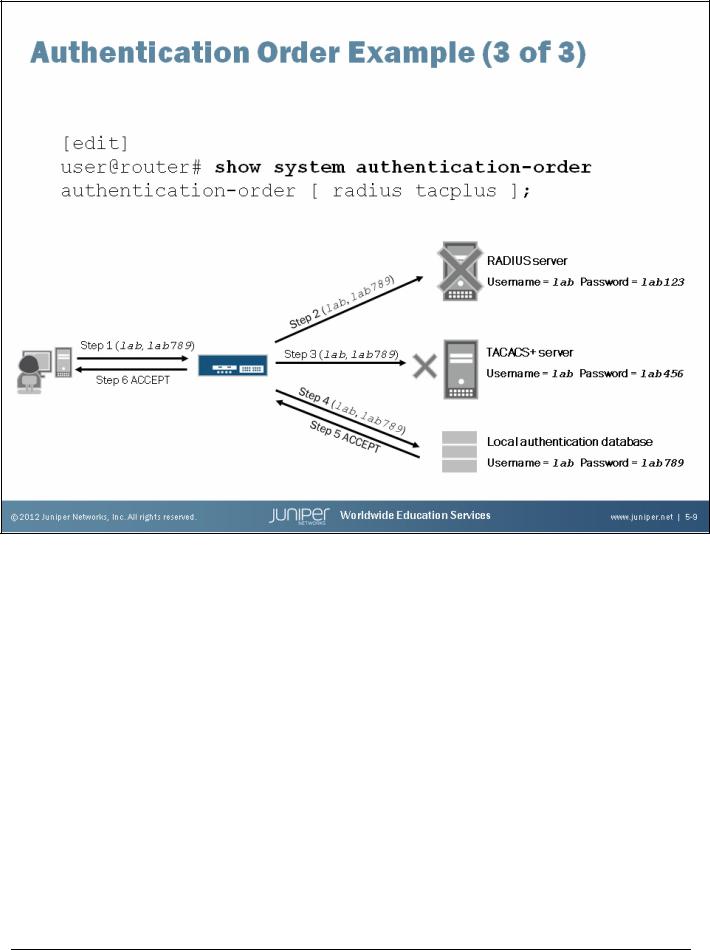
Introduction to the Junos Operating System
Example 3
In this example, authentication-order [ radius tacplus ] is still configured. We entered a username of lab and a password of lab789. The Junos OS attempted to authenticate the password against the RADIUS server, which is down. The device running the Junos OS received no response, and after a timeout period, tried the TACACS+ server. A temporary network problem caused the TACACS+ server to be unreachable. After a timeout period, local authentication was consulted and the password was accepted. The Junos OS consulted local authentication because none of the configured authentication methods responded.
www.juniper.net |
Secondary System Configuration • Chapter 5–9 |
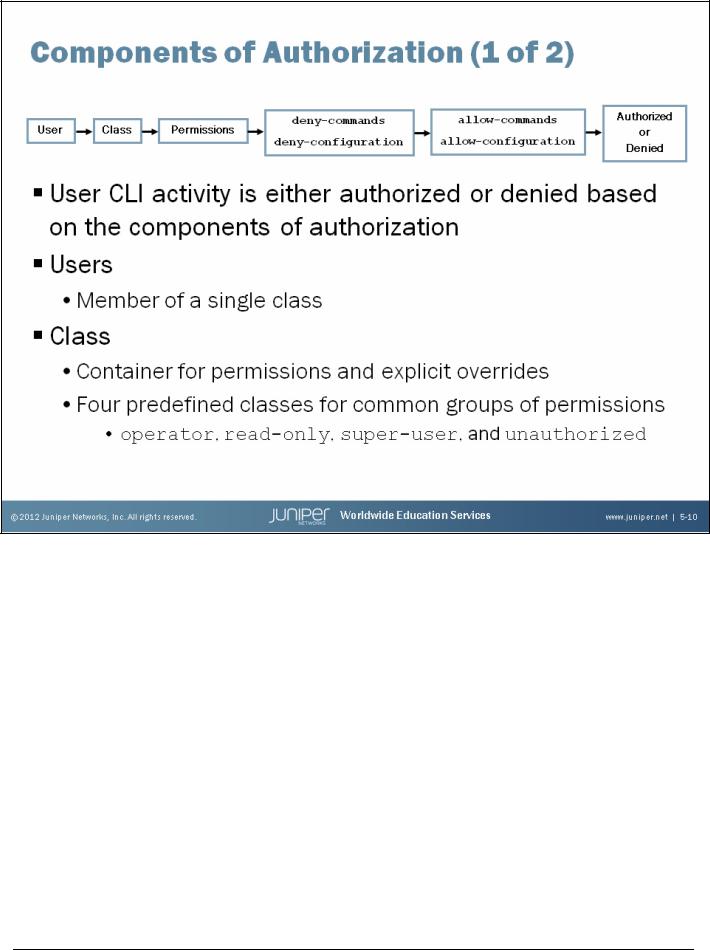
Introduction to the Junos Operating System
Authorization Overview
Each command or configuration statement is subject to authorization. The Junos OS applies authorization to all nonroot users, and you cannot disable this feature. Authorization applies to both the J-Web interface and the command-line interface (CLI). A configured hierarchy of authorization components, as shown by the graphic on the slide, defines whether a command is authorized.
Users
At the highest level, the configuration of user accounts define authorization parameters. As previously mentioned, multiple remotely authenticated users can be mapped to a locally defined template user. Users are members of a single login class.
Two variations of superuser class exist (super-user and superuser). The superuser class is hidden but can still be used. Both class references provide all permissions.
Class
A login class is a named container that groups together a set of one or more permission flags. Login classes can also specify that the permission flags should be overridden for certain commands. You can configure custom login classes, but there are four predefined login classes that exist to handle most situations. These classes and associated permission flags are the following:
•super-user: All permissions;
•operator: Clear, network, reset, trace, and view permissions;
•read-only: View permissions; and
•unauthorized: No permissions.
Chapter 5–10 • Secondary System Configuration |
www.juniper.net |
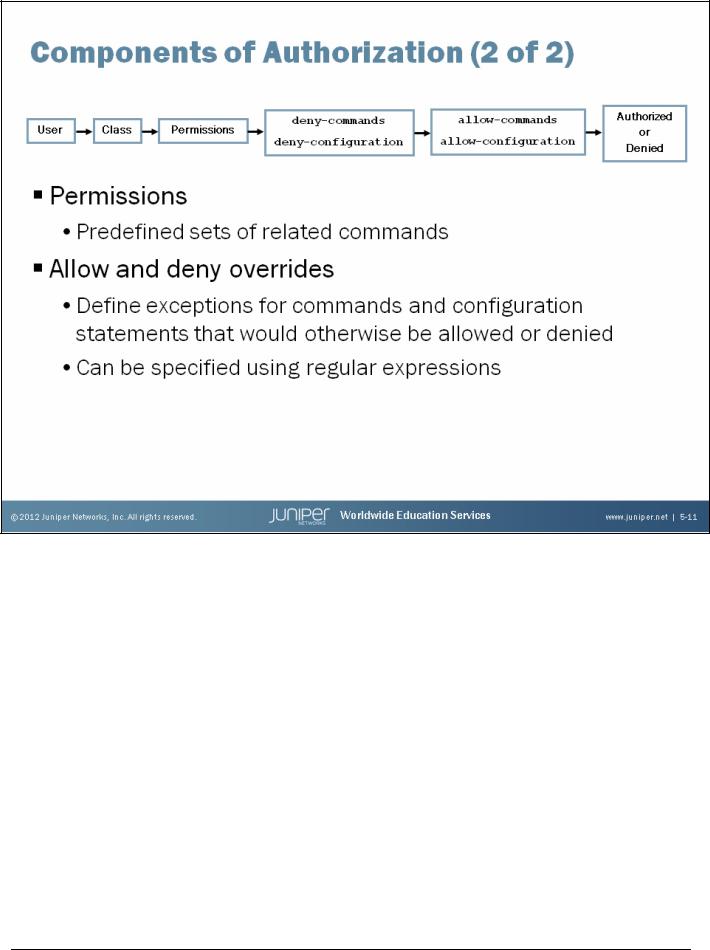
Introduction to the Junos Operating System
Because the Junos OS is modular and is used on multiple platforms, some permissions listed here might not be applicable to all platforms running the Junos OS.
Permissions
The following predefined permission flags group together the authorization of related commands:
•access: Allows the viewing of network access configuration;
•access-control: Allows the modifying of network access configuration;
•admin: Allows the viewing of user accounts;
•admin-control: Allows the modifying of user accounts;
•all: Enables all permission bits to be turned on;
•clear: Allows the clearing of learned network information;
•configure: Allows the entering of configuration mode;
•control: Allows the modifying of any configuration values (must be used in conjunction with the configure permission);
•field: Is reserved for field (debug) support;
•firewall: Allows the viewing of firewall configuration;
•firewall-control: Allows the modifying of firewall configuration;
•floppy: Allows the reading and writing of information to the floppy drive;
Continued on the next page.
www.juniper.net |
Secondary System Configuration • Chapter 5–11 |

Introduction to the Junos Operating System
Permissions (contd.)
•flow-tap: Allows the viewing of flow-tap configuration;
•flow-tap-control: Allows the modifying of flow-tap configuration;
•flow-tap-operation: Enables the tapping of flows;
•idp-profiler-operation: Enables IDP profiler;
•interface: Allows the viewing of interface configuration;
•interface-control: Allows the modifying of interface configuration;
•maintenance: Allows system maintenance, including starting a local shell on the device and becoming the superuser in the shell, and can halt and reboot the system;
•network: Allows network access;
•reset: Allows the resetting and restarting of interfaces and processes;
•rollback: Allows the ability to roll back for depth greater than zero;
•routing: Allows the viewing of routing configuration;
•routing-control: Allows the modifying of routing configuration;
•secret: Allows the viewing of secret configuration;
•secret-control: Allows the modifying of secret configuration;
•security: Allows the viewing of security configuration;
•security-control: Allows the modifying of security configuration;
•shell: Allows the starting of a local shell;
•snmp: Allows the viewing of SNMP configuration;
•snmp-control: Allows the modifying of SNMP configuration;
•system: Allows the viewing of system configuration;
•system-control: Allows the modifying of system configuration;
•trace: Allows the viewing of trace file settings;
•trace-control: Allows the modifying of trace file settings;
•view: Allows the viewing of current values and statistics; and
•view-configuration: Allows the viewing of all configuration (not including secrets).
The configurable permissions might vary between Junos devices and software versions. Refer to the technical publications for your specific device and version of the Junos OS.
Allow and Deny Overrides
You can use the deny-commands, allow-commands, deny-configuration, and allow-configuration statements to define regular expressions that match operational commands or configuration statements. Matches are explicitly allowed or denied, regardless of whether you set the corresponding permission flags. The Junos OS applies the deny- statements before the corresponding allow- statements, resulting in the authorization of commands that match both.
Chapter 5–12 • Secondary System Configuration |
www.juniper.net |
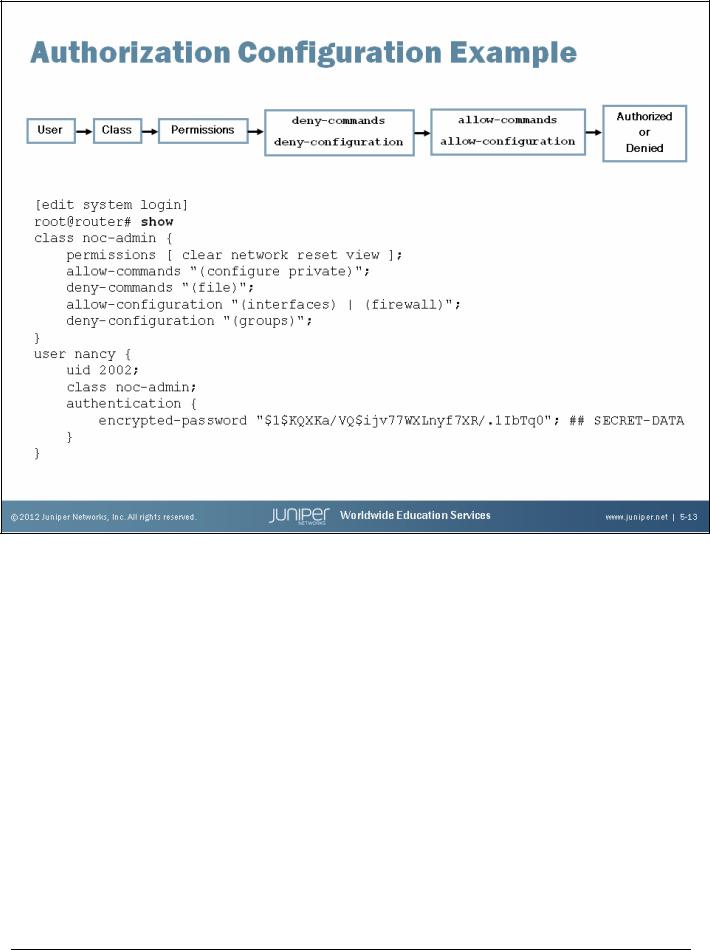
Introduction to the Junos Operating System
Authorization Example
The configuration example on the slide shows how the various authorization components are configured:
•User nancy is a member of the noc-admin class;
•The noc-admin class has the clear, network, reset, and view permissions;
•In addition, the noc-admin class can enter configuration mode using the configure private command and is allowed to alter configuration parameters at the [edit interfaces] and [edit firewall] hierarchy levels; and
•The noc-admin class is denied the ability to manipulate files using the operational mode’s file command and is specifically excluded from navigating to or viewing configuration details at the [edit groups] hierarchy level.
www.juniper.net |
Secondary System Configuration • Chapter 5–13 |
